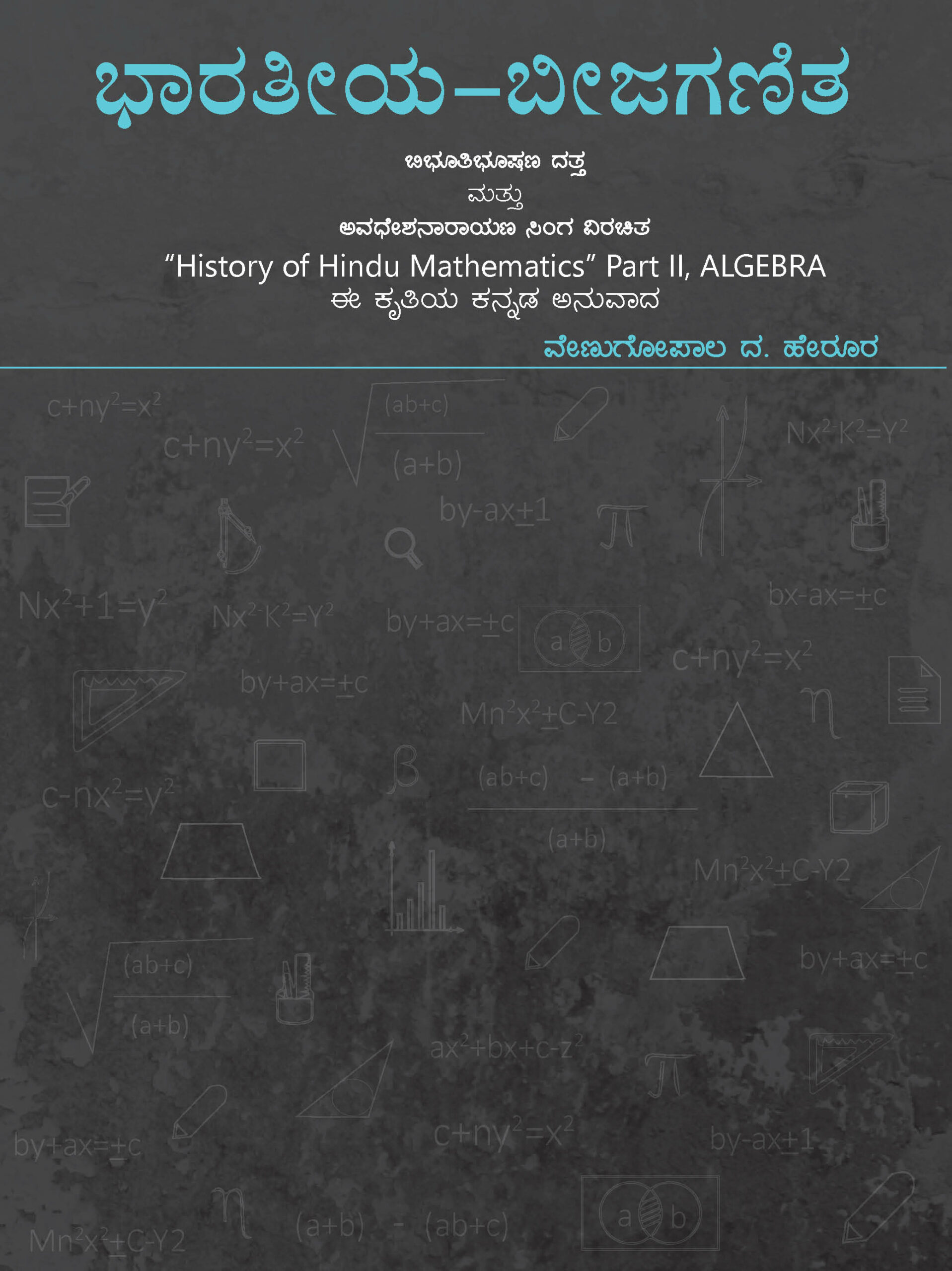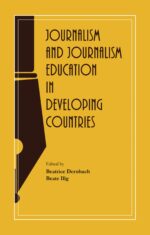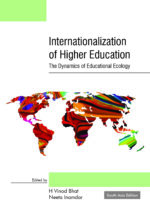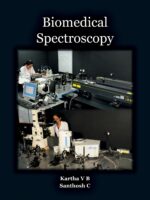Bharatiya Bijaganita
₹895.00
ಪ್ರಾಚೀನ ಭಾರತೀಯ-ಬೀಜಗಣಿತದಲ್ಲಿ ಅನಿರ್ಣೀತ ಸಮೀಕರಣಗಳ ಕುರಿತ ವಿಶ್ಲೇಷಣೆಯು (Indeterminate-analysis) ವಿಶೇಷ ಗಮನಾರ್ಹವಾದ ಸಂಗತಿಯಾಗಿದೆ. ಏಕಘಾತೀಯ ಅನಿರ್ಣೀತ ಸಮೀಕರಣಗಳ ಪರಿಹಾರಕ್ಕೆ ಸಂಬAಧಿಸಿದ ವಿಷಯದ ವಿಶ್ಲೇಷಣೆಯನ್ನು ಭಾರತೀಯ-ಬೀಜಗಣಿತಜ್ಞರು ‘ಕುಟ್ಟಕ’ ಎಂಬ ಪಾರಿಭಾಷಿಕ ಪದದಿಂದ ಸೂಚಿಸಿದರೆ, ಅನಿರ್ಣೀತ ವರ್ಗಸಮೀಕರಣಗಳ ವಿಶ್ಲೇಷಣೆಯನ್ನು ‘ವರ್ಗಪ್ರಕೃತಿ’ ಎಂದು ಕರೆದಿದ್ದಾರೆ. ಎರಡೂ ವಿಷಯಗಳನ್ನು ವಿಶದವಾಗಿ ಚರ್ಚಿಸಿದೆ. ಚಿಹ್ನೆಗಳ-ಬಳಕೆ, ಅವ್ಯಕ್ತಗಳನ್ನು ಸೂಚಿಸುವುದಕ್ಕಾಗಿ ಬಳಸುವ ಅಕ್ಷರಸಂಕೇತಗಳು, ಸಮೀಕರಣಗಳು ಬೀಜಗಣಿತಶಾಸ್ತçದ ಮೂಲಾಧಾರಗಳಾಗಿವೆ. ಅವ್ಯಕ್ತಗಳನ್ನು ಸೂಚಿಸುವುದಕ್ಕಾಗಿ ಶಿಸ್ತುಬದ್ಧವಾಗಿ ಅಕ್ಷರಸಂಕೇತಗಳನ್ನು ಪ್ರಪ್ರಥಮವಾಗಿ ಬಳಸಿದವರು ಭಾರತೀಯರು. ವಿವಿಧ ಬಗೆಯ ಸಮೀಕರಣಗಳನ್ನು ವಿಭಿನ್ನ-ವರ್ಗಗಳಲ್ಲಿ ವಿಂಗಡಿಸಿ, ಅವುಗಳ ವಿಸ್ತöÈತ ಅಧ್ಯಯನವನ್ನು ಪ್ರಪ್ರಥಮವಾಗಿ ಕೈಗೊಂಡವರೂ ಅವರೇ ಆಗಿದ್ದಾರೆ. ಹಾಗಾಗಿ, ಬೀಜಗಣಿತವನ್ನು ಶಾಸ್ತçದ-ಸ್ವರೂಪದಲ್ಲಿ ಹುಟ್ಟುಹಾಕಿ ಮುನ್ನಡಿಸಿದವರೂ ಅವರೇ ಎಂದು ಹೇಳಬಹುದಾಗಿದೆ. ಪ್ರಸ್ತುತ ಕೃತಿಯು ಬೀಜಗಣಿತದ ಸಮೀಕರಣಗಳನ್ನು ಬಿಡಿಸುವುದಕ್ಕೆ ಅವಶ್ಯವಾಗಿರುವ ಪ್ರಕ್ರಿಯೆಗಳನ್ನು ಅಥವಾ ಪರಿಕರ್ಮಗಳನ್ನು ಅರ್ಥಾತ್ “ಬೀಜೋಪಯೋಗಿ-ಗಣಿತ”ವನ್ನು ಮತ್ತು ಬೀಜಗಣಿತೀಯ ಸಮೀಕರಣಗಳ ವಿಶ್ಲೇಷಣೆಯ ಕುರಿತು ಚರ್ಚೆ “ಬೀಜ” ಎರಡನ್ನೂ ಒಳಗೊಂಡಿದೆ. ಪ್ರಾಚೀನ ಆಚಾರ್ಯರು ನಿರೂಪಿಸಿರುವ ನಿಯಮಗಳಿಗೆ ಉಪಪತ್ತಿಯನ್ನು ಒದಗಿಸಿರುವುದು, ಮತ್ತು ಸ್ಪಷ್ಟೀಕರಣಕ್ಕಾಗಿ ಕೊಟ್ಟಿರುವ ಉದಾಹರಣೆ ಲೆಕ್ಕವನ್ನು ಆಯಾ ಗ್ರಂಥಕರ್ತನು ತಿಳಿಸಿರುವ ವಿಧಾನದನ್ವಯವೇ ಆಧುನಿಕ ಗಣಿತೀಯ-ಸಂಕೇತಗಳನ್ನು ಹಾಗೂ ಚಿಹ್ನೆಗಳನ್ನು ಬಳಸಿ ಪೂರ್ತಿಯಾಗಿ ಬಿಡಿಸಿ ತೋರಿಸಿರುವುದು ಈ ಕೃತಿಯ ವಿಶೇಷ ಮಹತ್ವದ ಸಂಗತಿಯಾಗಿವೆ. ಅಲ್ಲಲ್ಲಿ,
Out of stock
| Category: | Academic and Reference |
|---|
| Author | |
|---|---|
| Format |
Related products
-
Childhood Cancer
₹185.00Authors: H S Ballal, P D Gupta
Childhood Cancer is a major medical problem in most of the societies of the modern world. Though enough literature is available on the subject, it is not easily intelligible to common people. An ordinary parent whose ward is affected by any form of childhood cancer would beat a loss without the basic information. This book is aimed at educating a non-professional who wishes to grasp the problem in detail and in a simple way. The book primarily deals with the signs and symptoms of cancer in children which enable early detection. It is written in a lucid manner to remove the myth among parents that diagnosis of cancer in children amounts to a death sentence. Many of the childhood cancers, if detected early, can be cured completely, and the patients can live the rest of their lives like any other normal people. The book is an attempt to create this awareness among parents through proper information about the disease. Further, the book would also serve as a manual for MBBS students and professionals in other fields for primary treatment and management of the childhood cancer patients.
Interested customers may write to us at mup@manipal.edu about purchasing the book.
Also available on

-
Journalism and Journalism Education in Developing Countries
₹550.00Editors: Beate Illg, Beatrice Dernbach
Free and fair media are at the heart of any democratic set up. A thriving field of journalism and zealous and ethical journalists in that sense become torch bearers of a brighter and promising tomorrow. In this light, the status of journalists, the most important actors in the field becomes increasingly important as a matter of study. They act as gatekeepers of information that is flooding in the era of new media, a wave that is not so new anymore. Their roles remain intact and even becomes prominent in the chaos of many-to-many communication.
Not concentrating on specific countries, selected contributions in the book reflect on the developments of media and journalism education across different countries. Introducing the book with an overview about the state-of-the-art of journalism education and the research on a meta level, the book moves on to talk about media studies in the Asian countries and in Arab world, the African States and Brazil.
The recent economic and social developments present both opportunities and risks for journalism. Freedom of expression and freedom of press, even in democratic countries, are under pressure. This book provides an international perspective on the different aspects of journalism – the situation in which journalists work, their working conditions, educational backgrounds, struggles and successes. It is aimed at an international public interested in the field of journalism and freedom of speech. It addresses journalists, trainers and academics. Furthermore, institutions in the field of development cooperation, education or cultural policy and cultural education are the focus of this work. Though the book is focused on journalism and journalism education in developing countries, contributions are from across the globe. This book is an interesting read for all those who care about a vital media landscape and an open democratic society.Interested readers may write to us at mup@manipal.edu about purchasing the book.
-
Internationalization of Higher Education: The Dynamics of Educational Ecology
₹500.00Editors: H Vinod Bhat, Neeta InamdarThe mobility of scholars seeking knowledge has been a part of the university ideal for centuries. History holds testimony to the fact that these mobilities have also altered the lives of people in different regions. Universities have played a pivotal role in the movement of people across borders and the resultant transformation of societies due to transcultural interactions.In this book, the editors have brought together ideas on the changing dynamics of these mobilities of scholars and the interconnectedness of higher education institutions in today’s world. An attempt is also made to record the implications of these international collaborations in knowledge generation and dissemination within the educational ecology. The notion of educational ecology is explored through the articles in the book to comprehend the power play that exists in the dimension and the direction of internationalization of higher education. All this is done with the hope that the opening up of education to global opportunities may, over a period of time, lead to equitable distribution of opportunities worldwide.Interested readers may write to us at mup@manipal.edu about purchasing the book.
International Edition available on South Asia Edition available on -
Transformation Beyond Sight
₹395.00Author: Jibu Thomas
Transformation Beyond Sight is a gripping narrative of the author’s experience in the hospital administration of Kasturba Hospital (KH), Manipal. As an experiential account, the present book provides insights into the thoughts, concerns, and apprehensions of prospective hospital administrators, and spotlights the vital role played by a hospital administrator in the day-to-day operations of KH, which is also an advanced healthcare facility.This book draws attention to the transformational quality of the author’s experiences to emphasize that the evolution in leadership and management of the teaching hospital went hand-in-hand with the transformation of the author’s administrative skills, and his own persona as a diligent administrator. The biographical undertone also provides an insight into the complex and dynamic healthcare environment, alongside the competencies, creativity, and mindfulness necessary for an administrator. This book narrates a hospital administrator’s engagements with the traditional processes and his attempts to bring about effective changes in the management and monitoring of operations of KH and the overall management of a healthcare facility.
Interested readers may write to us at mup@manipal.edu about purchasing the book.
-
The Practice of Geopolitics
₹850.00Author: M D Nalapat
Intended to be a Practioner’s Guide to Geopolitics, the book provides a look into the thought processes that generate correct and timely analysis of global events. Geopolitics needs to weave within its analytical grasp economics, society, strategy and even culture, as the science deals with overall national capabilities as well as the mutal synergy and frictions between nations. Although a broad range of subjects has been covered in the book, each is anchored in the ground reality of events having a profound impact on the lives of citizens and on world events. The growing interconnectedness of the globe has resulted in a need to do away with the popular west centric models of international relations and to view events not through that single prism but from a holistic viewpoint that accepts the relevance and maturity of different histories and geographies. What the book provides is an alternative Weltanschauung to the dominant models of geopolitical analysis, so that the science is enabled to cross beyond the narrow boundaries which have confined. The scope and applicability of its analysis. The rise of Asia needs a geopolitical vision unique to the continent, and this is what has been provided by Professor Nalapat.
Interested readers may write to us at mup@manipal.edu about purchasing the book.
-
A Concise Textbook of Drug Regulatory Affairs
₹290.00This book has 12 chapters covering nearly all the areas of Drug Regulatory Affairs. Various aspects of Drug Regulatory Affairs such as new drug approval procedure, pharmacovigilance, product recall, evolution of drug regulations in the United States of America (USA) and process of drug approval in the USA and European Union, bioequivalence regulations, electronic Common Technical Documents (eCTD), environmental regulations, orphan drugs pharmaceutical pricing and control policy, Pharmacovigilance system in India and the USA, Product Recall, regulations of pharmaceutical drug promotion and Pharmacy Practice regulations are covered in this book. As a whole, the book is a comprehensive reference book on regulatory affairs and will be very useful for the practicing professionals and students alike.
Interested readers may write to us at mup@manipal.edu about purchasing the book.
-
Linear Algebra with Applications
₹650.00Linear Algebra with Applications portrays selected articles published earlier by Prof Ravindra B Bapat in various reputed journals. This volume published in honour of Prof Bapat, on the occasion of his 60th birthday, consists of his original research articles written in the area of (i) Permanent, Determinant and their applications, (ii) Non-negative Matrices, (iii) Matrix Methods in Statistics and Graph theory, and (iv) Generalized Inverses of a Matrix. Starting with an article A Generalization of a Theorem of Ky Fan on Simplicial Maps, his first article published in 1980, several articles probing the properties of permanent and determinant, characterization of generalized inverses, spectral properties of graphs, and applications of matrix methods in statistics are compiled in this volume. The articles selected in this book will certainly inspire the young linear algebraists and provide several matrix techniques to solve different problems in the area of applied linear algebra.
Interested readers may write to us at mup@manipal.edu about purchasing the book.
-
Biomedical Spectroscopy
₹2,950.00Author: Santhosh C, Vasudevan Baskaran Kartha
Biomedical spectroscopy is the output of the intensive discussions of the authors and the medical professionals of Kasturba Medical College, Manipal University. The ?Centre for Laser Spectroscopy?, a centre for developing biomedical applications of laser spectroscopic methods, was established at Manipal University in 1997. The scientists of the Centre, together with the physicians, surgeons, and pathologists of the KMC, initiated a number of research programs in this area. The main aim of the Centre was to develop spectroscopic methods for early detection, screening, monitoring therapy and identification of disease markers, with special emphasis on various cancers, so that these techniques can be applied for routine healthcare applications. Outcome of these research activities are covered in the book. A common platform of information can provide a more open communication enabling faster and better evolution of the spectroscopic methods for biomedical applications.
Interested readers may write to us at mup@manipal.edu about purchasing the book.
International Edition available on South Asia Edition available on










